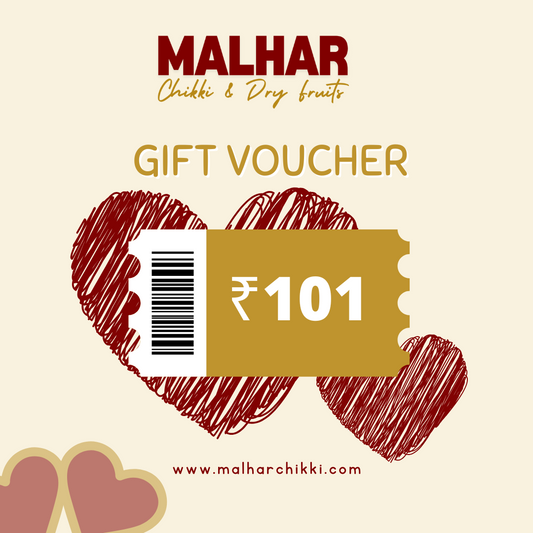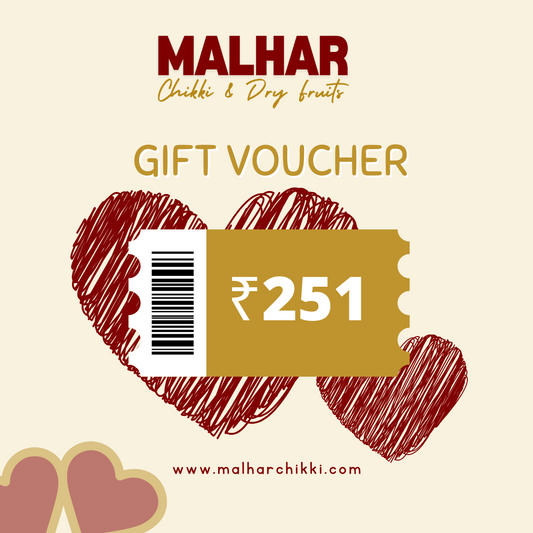Collection: Dry Fruit Chikki
-
Khajur Dry Fruit Chikki
Vendor:Malhar Chikki5.0 / 5.0
(2) 2 total reviews
Regular price From ₹. 199.00Regular priceUnit price / per₹. 238.00Sale price From ₹. 199.00Sale -
Malhar Special Protein Bar
Vendor:Malhar ChikkiRegular price From ₹. 288.00Regular priceUnit price / per₹. 360.00Sale price From ₹. 288.00Sale -
Anjeer (Fig) Dry Fruit Chikki
Vendor:Malhar ChikkiRegular price From ₹. 240.00Regular priceUnit price / per₹. 299.00Sale price From ₹. 240.00Sale -
Rose Petals Dry Fruit Chikki
Vendor:Malhar Chikki5.0 / 5.0
(1) 1 total reviews
Regular price From ₹. 215.00Regular priceUnit price / per₹. 296.00Sale price From ₹. 215.00Sale -
Malhar Chikki Gift Card
Vendor:Malhar ChikkiRegular price From ₹. 101.00Regular priceUnit price / per -
Khajur & Anjeer Dry Fruit Chikki Combo
Vendor:Malhar ChikkiRegular price From ₹. 619.00Regular priceUnit price / per -
Malhar Mixed Dry Fruit Chikki
Vendor:Malhar ChikkiRegular price From ₹. 240.00Regular priceUnit price / per₹. 299.00Sale price From ₹. 240.00Sale
The History About Dry Fruit Chikki
Dry Fruit Chikki, a beloved Indian sweet, has deep cultural and historical roots dating back several centuries. Originating from the Indian subcontinent, Chikki is a traditional brittle made primarily from jaggery (unrefined cane sugar) and nuts or seeds. While the classic version is made with peanuts, the dry fruit variant gained popularity due to its richer taste, nutritional value, and luxurious appeal. Over time, Dry Fruit Chikki has evolved from a local delicacy into a symbol of festive celebration and health-conscious indulgence.
The story of Chikki begins in the western Indian state of Maharashtra, particularly in the town of Lonavala. During the British colonial period, Lonavala was a key stop along the railway connecting Mumbai and Pune. To cater to the growing number of railway passengers, local sweet makers began selling jaggery and peanut brittle as a nutritious snack. It was inexpensive, had a long shelf life, and provided instant energy. This snack quickly became popular and came to be known as “Chikki.”
As its popularity spread, variations of the original Chikki began to emerge. Dry Fruit Chikki, in particular, became a favored version among the elite and health-conscious due to its rich ingredients like almonds, cashews, pistachios, and walnuts. These nuts added not only flavor but also a wealth of nutrients, making the treat more than just a sweet—it became a healthy energy booster. The use of jaggery, instead of refined sugar, contributed further to its image as a health-friendly snack.
In ancient Indian texts and Ayurveda, jaggery and dry fruits have been praised for their medicinal properties. Jaggery is known for aiding digestion, improving immunity, and purifying the blood. Dry fruits, rich in good fats, vitamins, and antioxidants, were seen as strength-giving foods, especially recommended during the cold winter months. Thus, Dry Fruit Chikki found its place in Indian households not only as a dessert but also as a seasonal health supplement.
The sweet also holds a significant place in Indian festivals and traditions. During Makar Sankranti, a harvest festival celebrated in January, Chikki is distributed widely among friends and family. It symbolizes sharing of sweetness and good health. In regions like Gujarat and Maharashtra, exchanging different varieties of Chikki is a common custom during this time.
With modernization and changing lifestyles, Chikki has also transformed. Artisanal brands and organic producers have taken up the traditional recipe, enhancing it with exotic ingredients like saffron, cardamom, rose petals, and seeds like flax and chia. However, the essence remains the same: a crunchy, wholesome snack that connects generations and traditions.
Today, Dry Fruit Chikki is not just an Indian delicacy but is also appreciated globally. It is sold in gourmet stores, exported to Indian diaspora communities, and enjoyed as a healthy alternative to processed sweets. From railway platforms to high-end boutiques, the journey of Dry Fruit Chikki is a sweet tale of tradition, taste, and timeless appeal.













